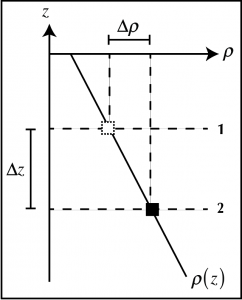22 Stratification and buoyancy forces
If water parcels are not uniform in density, the state of rest is one where the fluid is stratified, i.e., water parcels with greater density sit below water parcels of less density.
Key Takeaways
There are a number of metrics for the strength of the stratification, the name given to the vertical component of the density gradient, ![]() . One of the most common is N, the buoyancy frequency (we will later talk about why it has this name), defined as:
. One of the most common is N, the buoyancy frequency (we will later talk about why it has this name), defined as:
![Rendered by QuickLaTeX.com \[ N = \sqrt{-\frac{g}{\rho_0}\frac{\partial \rho}{\partial z}} \]](https://uw.pressbooks.pub/app/uploads/quicklatex/quicklatex.com-31be8c7ed0267b97a7b458e1c8e4f645_l3.png)
If a water parcel is displaced vertically away from its equilibrium position in a stratified fluid, then a force opposing this motion occurs, restoring the stratification. This force is called the buoyancy force.

Mathematically, let’s consider two water parcels, WP1 and WP2 with densities ![]() , in a linearly stratified fluid (i.,e.,
, in a linearly stratified fluid (i.,e., ![]() is a negative constant number). Move WP1 vertically down to the level where the fluid density is
is a negative constant number). Move WP1 vertically down to the level where the fluid density is ![]() , without changing its density. This involves a change in depth of
, without changing its density. This involves a change in depth of ![]() that is negative for a downward displacement.
that is negative for a downward displacement.
From hydrostatic balance, the pressure gradient at the lower level is
![]()
The net upward force on WP1 per unit mass of WP1 due to pressure forces from the surrounding fluid is
![]()
Key Takeaways
![]()
Thus, the buoyancy force on the displaced water parcel depends on the percentage of its density difference from the surrounding water.
In our linear stratification, or in a linear neighborhood of a general stratification assuming a small displacement, ![]() , the density difference is
, the density difference is ![]() . Thus, for a given displacement size, the strength of the buoyancy force depends on the strength of the water column stratification.
. Thus, for a given displacement size, the strength of the buoyancy force depends on the strength of the water column stratification.
The buoyancy force can be seen to be closely related to our stratification metric, N, since density variations are small, ![]() , and
, and
![]()
A downward displacement, ![]() , generates an upward buoyancy force, and vice versa.
, generates an upward buoyancy force, and vice versa.
Mini-lectures for class:
Media Attributions
- VerticalStratDisplacement-1 © Susan Hautala is licensed under a CC BY-NC-SA (Attribution NonCommercial ShareAlike) license

